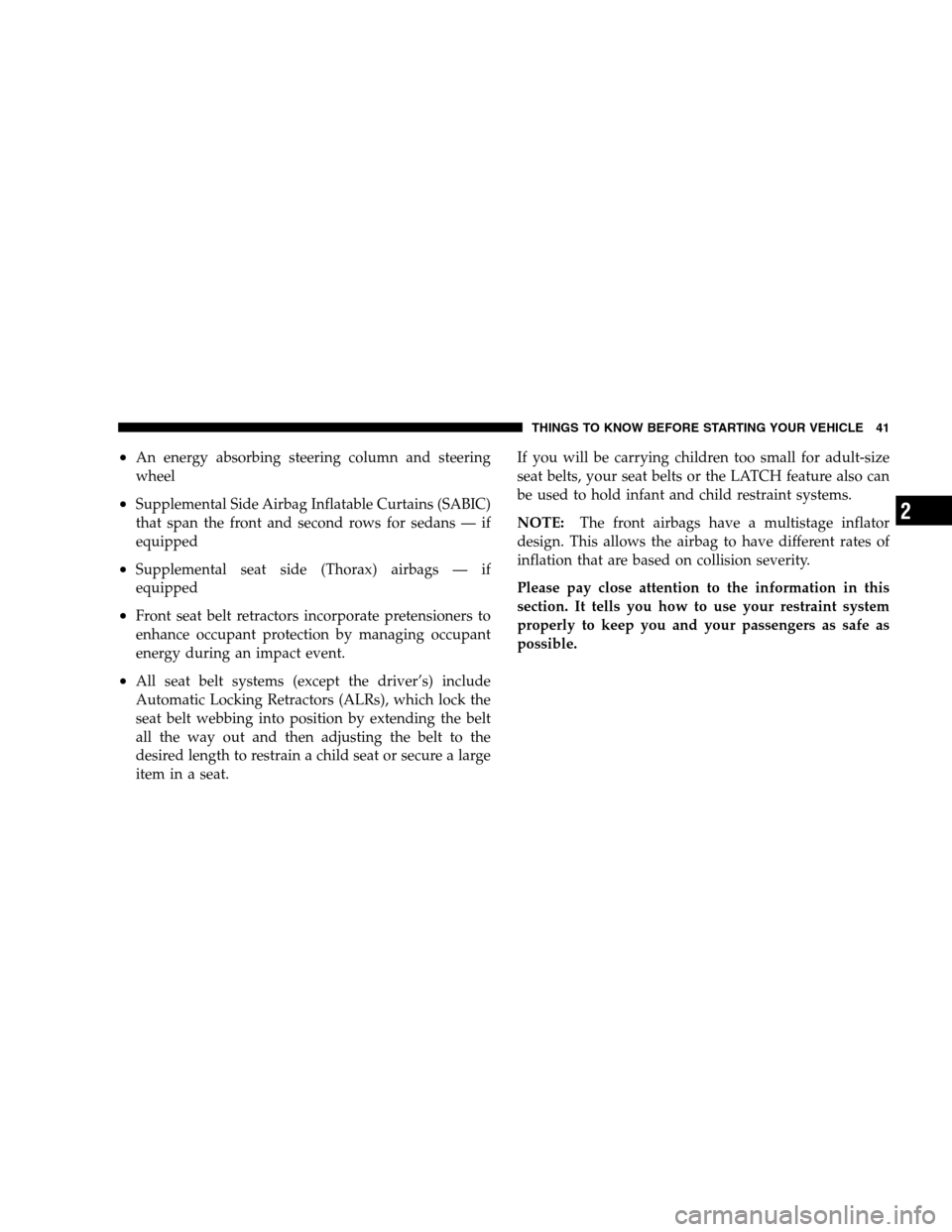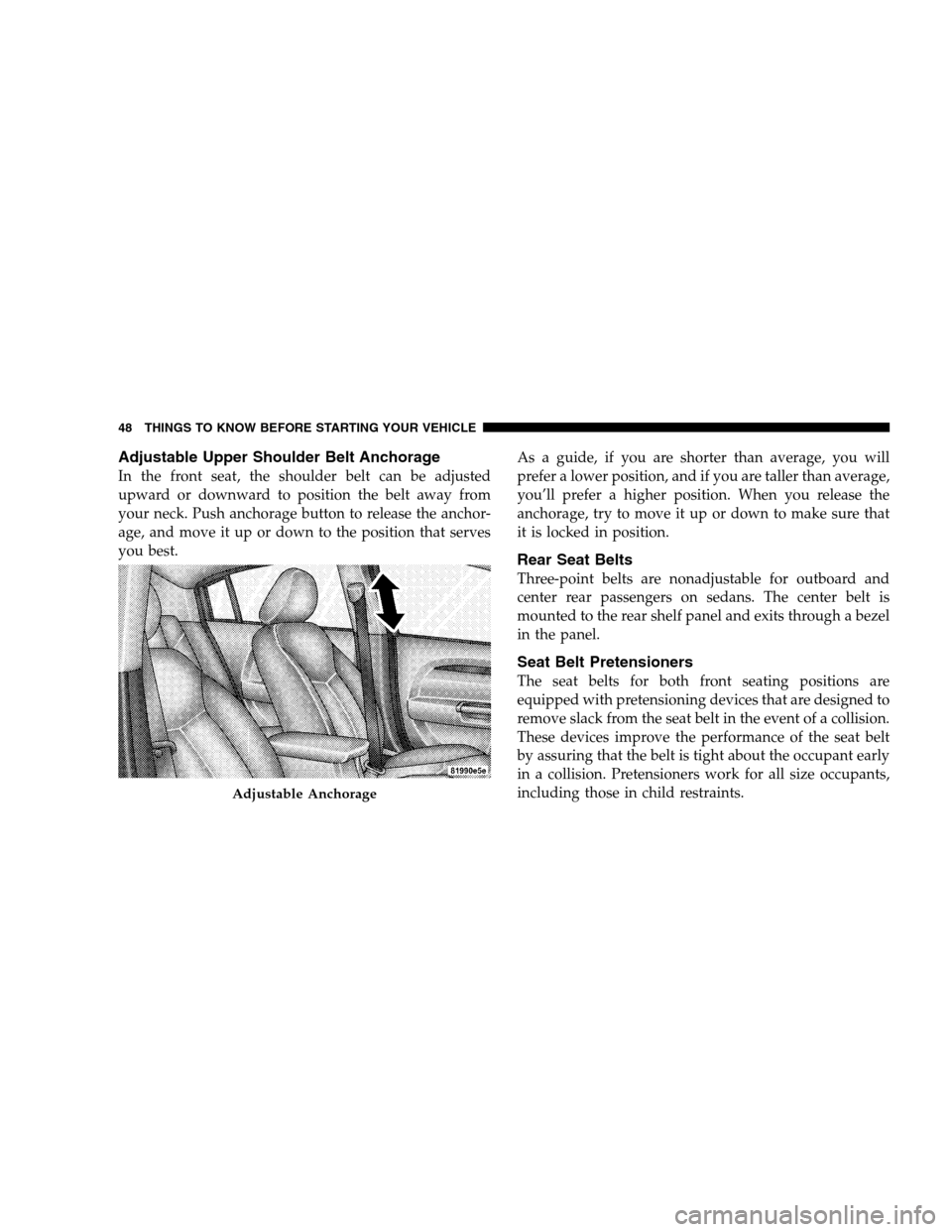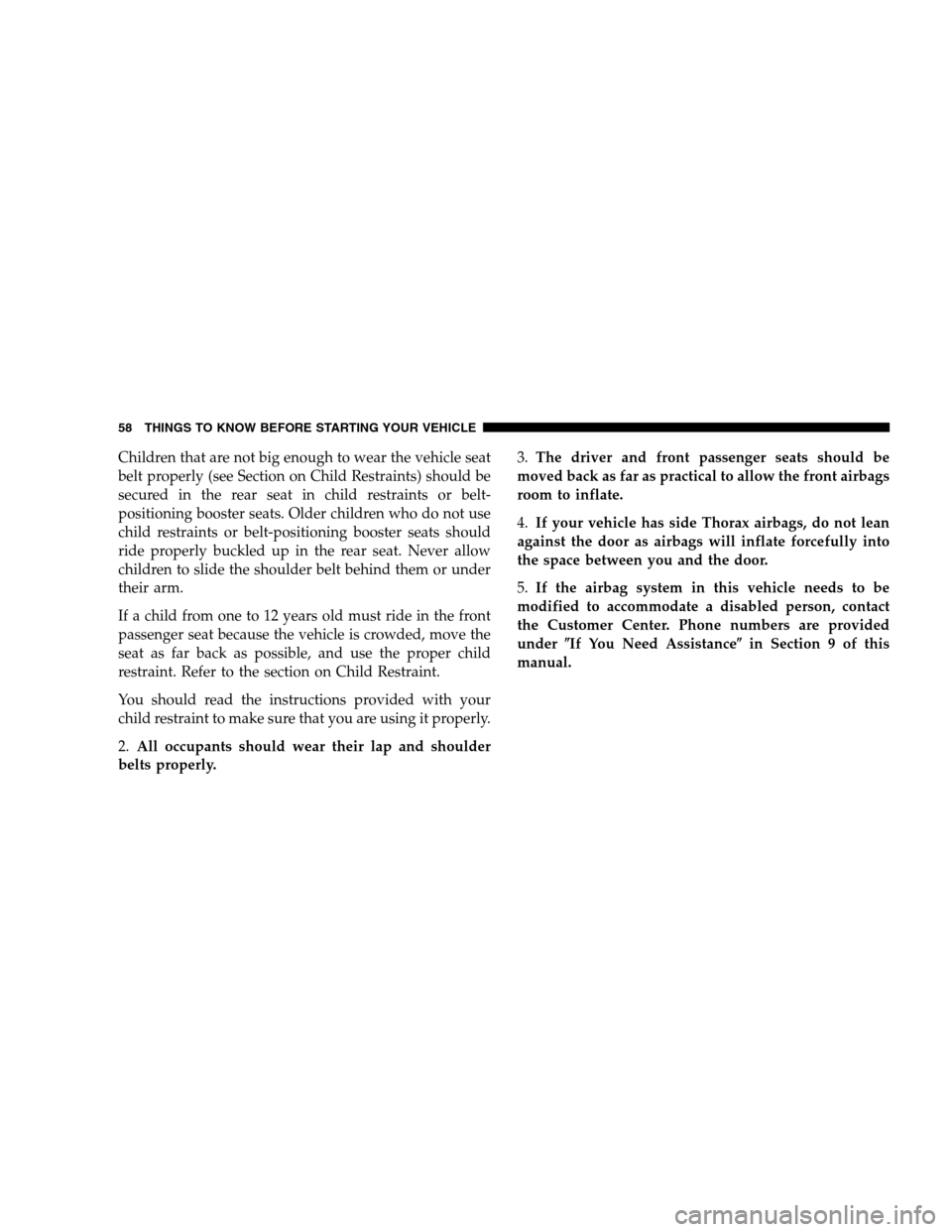Page 13 of 494
▫Rear Seat Belts........................48
▫Seat Belt Pretensioners...................48
▫Enhanced Seat Belt Reminder System
(BeltAlert�) ..........................49
▫BeltAlert�Programming.................49
▫Automatic Locking Mode................50
▫Seat Belts And Pregnant Women............51
▫Seat Belt Extender......................51
▫Supplemental Restraint System (SRS) - Airbag . .52
▫Airbag System Components...............53
▫Front Seat Airbag Features................53▫Airbag Deployment Sensors And Controls.....59
▫Event Data Recorder (EDR)...............65
▫Child Restraint........................67
�Engine Break-In Recommendations...........78
�SafetyTips ............................78
▫Exhaust Gas..........................78
▫Safety Checks You Should Make Inside
TheVehicle ..........................79
▫Periodic Safety Checks You Should Make
Outside The Vehicle....................80
THINGS TO KNOW BEFORE STARTING YOUR VEHICLE 11
2
Page 41 of 494
With the ignition ON, the word “deck” will display in
place of the odometer display indicating that the trunk is
open. The odometer display will reappear once the trunk
is closed or if the trip button is depressed.
With the key in the lock position or with the key out, the
word “deck” will display until the trunk is closed.
On EVIC-equipped vehicles, the words “Trunk Ajar” will
display.TRUNK SAFETY WARNING
WARNING!
Do not allow children to have access to the trunk,
either by climbing into the trunk from outside, or
through the inside of the vehicle. Always close the
trunk lid when your vehicle is unattended. Once in
the trunk, young children may not be able to escape,
even if they entered through the rear seat. If trapped
in the trunk, children can die from suffocation or
heat stroke.
THINGS TO KNOW BEFORE STARTING YOUR VEHICLE 39
2
Page 43 of 494

•An energy absorbing steering column and steering
wheel
•Supplemental Side Airbag Inflatable Curtains (SABIC)
that span the front and second rows for sedans — if
equipped
•Supplemental seat side (Thorax) airbags — if
equipped
•Front seat belt retractors incorporate pretensioners to
enhance occupant protection by managing occupant
energy during an impact event.
•All seat belt systems (except the driver’s) include
Automatic Locking Retractors (ALRs), which lock the
seat belt webbing into position by extending the belt
all the way out and then adjusting the belt to the
desired length to restrain a child seat or secure a large
item in a seat.If you will be carrying children too small for adult-size
seat belts, your seat belts or the LATCH feature also can
be used to hold infant and child restraint systems.
NOTE:The front airbags have a multistage inflator
design. This allows the airbag to have different rates of
inflation that are based on collision severity.
Please pay close attention to the information in this
section. It tells you how to use your restraint system
properly to keep you and your passengers as safe as
possible.
THINGS TO KNOW BEFORE STARTING YOUR VEHICLE 41
2
Page 50 of 494

Adjustable Upper Shoulder Belt Anchorage
In the front seat, the shoulder belt can be adjusted
upward or downward to position the belt away from
your neck. Push anchorage button to release the anchor-
age, and move it up or down to the position that serves
you best.As a guide, if you are shorter than average, you will
prefer a lower position, and if you are taller than average,
you’ll prefer a higher position. When you release the
anchorage, try to move it up or down to make sure that
it is locked in position.
Rear Seat Belts
Three-point belts are nonadjustable for outboard and
center rear passengers on sedans. The center belt is
mounted to the rear shelf panel and exits through a bezel
in the panel.
Seat Belt Pretensioners
The seat belts for both front seating positions are
equipped with pretensioning devices that are designed to
remove slack from the seat belt in the event of a collision.
These devices improve the performance of the seat belt
by assuring that the belt is tight about the occupant early
in a collision. Pretensioners work for all size occupants,
including those in child restraints.
Adjustable Anchorage
48 THINGS TO KNOW BEFORE STARTING YOUR VEHICLE
Page 52 of 494

3. Within 60 seconds of turning the ignition switch to the
ON position, unbuckle and then re-buckle the driver’s
seat belt at least three times within 10 seconds, ending
with the seat belt buckled.
NOTE:Watch for the Seat Belt Warning Light to turn on
while unbuckling and off while re-buckling the seat belt.
It may be necessary to retract the seat belt partially each
time when unbuckling.
4. Turn the ignition switch to the LOCK position. A
single chime will sound to signify that you have success-
fully completed the programming.
BeltAlert�can be reactivated by repeating this procedure.
NOTE:Although BeltAlert�has been deactivated, the
Seat Belt Warning Light will continue to illuminate while
the driver’s seat belt remains unbuckled.Automatic Locking Mode
In this mode, the shoulder belt is automatically pre-
locked. However, the belt will still retract to remove any
slack in the shoulder belt. The Automatic Locking Mode
is available on all passenger-seating positions. Use the
Automatic Locking Mode anytime a child safety seat is
installed in a passenger seating position. Children 12
years old and younger should be properly restrained in
the rear seat whenever possible.
How to Engage The Automatic Locking Mode
1. Buckle the combination lap/shoulder belt.
2. Grasp the shoulder portion and pull downward until
the entire belt is extracted.
3. Allow the belt to retract. As the belt retracts, you will
hear a clicking sound. This indicates the safety belt is
now in the Automatic Locking Mode.
50 THINGS TO KNOW BEFORE STARTING YOUR VEHICLE
Page 59 of 494

WARNING!
•If your vehicle is equipped with left and right
window bags, do not stack luggage or other cargo
up high enough to block the location of the Side
Airbag Inflatable Curtains (SABIC). The area
where the side curtain airbag is located should
remain free from any obstructions.
•Do not attach cup holders or any other objects on
or around the door. The inflating side airbag could
drive the object into occupants, causing serious
injury.
Airbags inflate in moderate to high speed impacts. Along
with seat belts and pretensioners, front airbags, and side
airbags work with the knee bolsters to provide improved
protection for the driver and front passenger.The seat belts are designed to protect you in many types
of collisions. The front airbags deploy in moderate to
severe frontal collisions. If your vehicle is equipped, the
side airbag on the crash side of the vehicle is triggered in
moderate to severe side collisions. In certain types of
collisions, both the front and side airbags may be trig-
gered. However, even in collisions where the airbags
work, you need the seat belts to keep you in the right
position for the airbags to protect you properly.
Here are some simple steps you can take to minimize the
risk of harm from a deploying airbag.
1.Children 12 years old and younger should always
ride buckled up in a rear seat.
Infants in rear facing child restraints shouldNEVERride
in the front seat of a vehicle with a passenger front airbag.
An airbag deployment can cause severe injury or death to
infants in that position.
THINGS TO KNOW BEFORE STARTING YOUR VEHICLE 57
2
Page 60 of 494

Children that are not big enough to wear the vehicle seat
belt properly (see Section on Child Restraints) should be
secured in the rear seat in child restraints or belt-
positioning booster seats. Older children who do not use
child restraints or belt-positioning booster seats should
ride properly buckled up in the rear seat. Never allow
children to slide the shoulder belt behind them or under
their arm.
If a child from one to 12 years old must ride in the front
passenger seat because the vehicle is crowded, move the
seat as far back as possible, and use the proper child
restraint. Refer to the section on Child Restraint.
You should read the instructions provided with your
child restraint to make sure that you are using it properly.
2.All occupants should wear their lap and shoulder
belts properly.3.The driver and front passenger seats should be
moved back as far as practical to allow the front airbags
room to inflate.
4.If your vehicle has side Thorax airbags, do not lean
against the door as airbags will inflate forcefully into
the space between you and the door.
5.If the airbag system in this vehicle needs to be
modified to accommodate a disabled person, contact
the Customer Center. Phone numbers are provided
under�If You Need Assistance�in Section 9 of this
manual.
58 THINGS TO KNOW BEFORE STARTING YOUR VEHICLE
Page 69 of 494

3. Requested by police under a legal warrant.
4. Otherwise required by law.
Data Parameters that May Be Recorded:
•Diagnostic trouble code(s) and warning light status for
electronically-controlled safety systems, including the
airbag system
•Airbag disable light status (if equipped)
•�Ti m e�of airbag deployment (in terms of ignition
cycles and vehicle mileage)
•Airbag deployment level (if applicable)
•Impact acceleration and angle
•Seat belt status
•Brake status (service and parking brakes)
•Accelerator status (including vehicle speed)
•Engine control status (including engine speed)
•Transmission gear selection
•Cruise control status
•Traction/stability control status
•Tire pressure monitoring system status – if equipped
Child Restraint
Everyone in your vehicle needs to be buckled up at all
times — babies and children, too. Every state in the
United States and all Canadian provinces require that
small children ride in proper restraint systems. This is the
law, and you can be prosecuted for ignoring it.
Children 12 years and younger should ride properly
buckled up in a rear seat, if available. According to crash
statistics, children are safer when properly restrained in
the rear seats, rather than in the front.
THINGS TO KNOW BEFORE STARTING YOUR VEHICLE 67
2